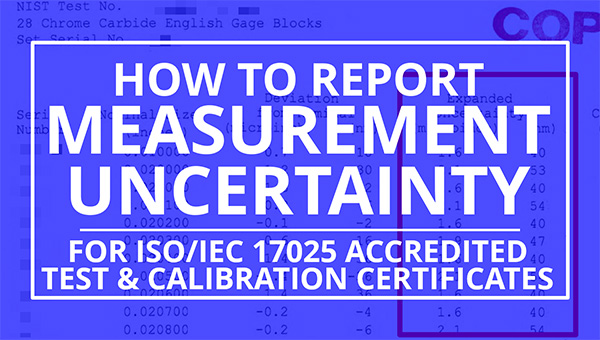
Introduction
Reporting measurement uncertainty in test and calibration certificates is a common practice for ISO/IEC 17025 accredited laboratories. It is also a common problem for a lot of laboratories.
Many struggle to do it right.
Most accredited laboratories are required to include uncertainty in their certificates. However, many of them do not know how to report uncertainty correctly.
Some of the most common deficiencies laboratories get cited for are;
- Not reporting uncertainty in certificates,
- Not reporting uncertainty correctly,
- Not reporting uncertainty to two significant figures,
- Not rounding uncertainty correctly,
- Reporting uncertainty smaller than their scope of accreditation.
Many of these deficiencies are easily avoidable. However, so much focus is put into learning how to estimate measurement uncertainty that many forget to learn how to report uncertainty.
The good news is the rules for reporting uncertainty have become much clearer over the last 10 years; and, today, we are going to cover them all!
In this guide, you will learn the requirements, the process, and the skills to report uncertainty in measurement.
Plus, I am going to give you plenty of examples from major laboratories that you can use to report uncertainty in your own certificates.
We are going to cover;
- Requirements for Reporting Uncertainty
- How to Report Uncertainty
- What are Significant Figures
- Rules for Rounding Uncertainty
- Reporting Uncertainty Examples
If you have questions about reporting measurement uncertainty in your certificates, then you are going to like this guide.
Let’s get started.
Requirements For Reporting Uncertainty
Whether you know it or not, there are rules to reporting uncertainty in your test and calibration certificates.
However, these rules have not always been around.
In the beginning, the GUM only provided recommendations, not rules. These recommendations were not heavily enforced, so laboratories used a variety of methods to report uncertainty.
Within the last decade, the recommendations from the GUM have started to become published in policies and standards.
As a result, accreditation bodies are starting to enforce these requirements. This means that you should become familiar with them and make sure they are implemented in your test or calibration certificates.
Therefore, we are going to cover the recommendations, policies, and requirements published in;
JCGM 100:2008
1. Reporting Expanded Measurement Uncertainty
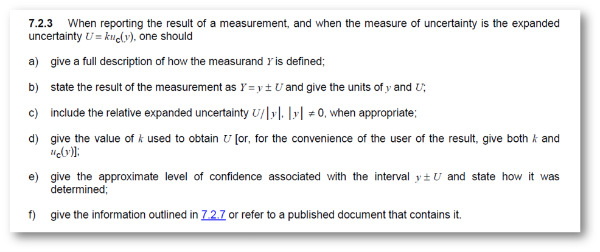
In section 7.2.3, the GUM states that you should include the following information when reporting the expanded measurement uncertainty;
- A full description the of the measurand Y,
- The measurement result, the measurement uncertainty, and the units of measure,
- Include the relative expanded uncertainty (e.g. percent) when appropriate,
- Give the value of the coverage factor (k),
- Give the confidence level associated with the reported uncertainty,
- Give a copy of your uncertainty budget or refer to a document that contains it (see sections 7.2.7 and 7.1.4).
2. Reporting the Measurement Results and Measurement Uncertainty

In section 7.2.4, the GUM states that you should report measurement results, for maximum clarity, similar to the example below;

3. Round Uncertainty to Two Significant Digits

In section 7.2.6, the GUM states that you should not report an excessive number of digits and recommends to round measurement uncertainty to two significant figures.
ILAC P14:01/2013
1. Reporting Uncertainty in Calibration Reports
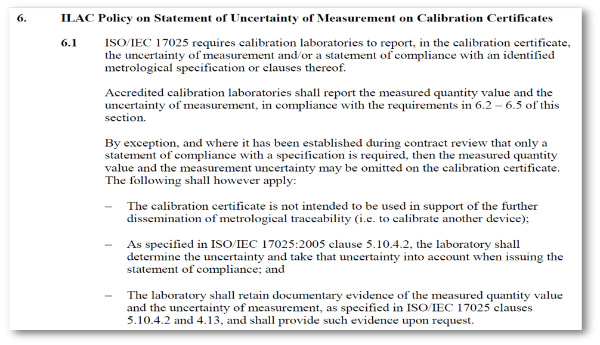
In section 6.1, the ILAC P14 policy states that a calibration laboratory should report uncertainty;
- In the calibration report,
- With the measurement result
Additionally, section 6.1 provides exceptions to reporting uncertainty as long as you obtain an agreement with the customer and meet the listed criteria.
2. Requirements for Calibration Certificates
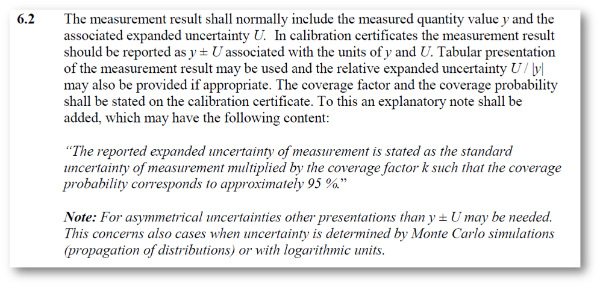
In section 6.2, the policy states that you should report the measured value and the measurement uncertainty together, and include the associated units of measure for both.
Optionally, you can present the results in a table or provide the measurement uncertainty as relative expanded uncertainty (e.g. percent).
Finally, you will need to add a note or statement explaining the coverage factor and coverage probability of your reported measurement uncertainty values.
3. Rounding Uncertainty for Calibration Certificates
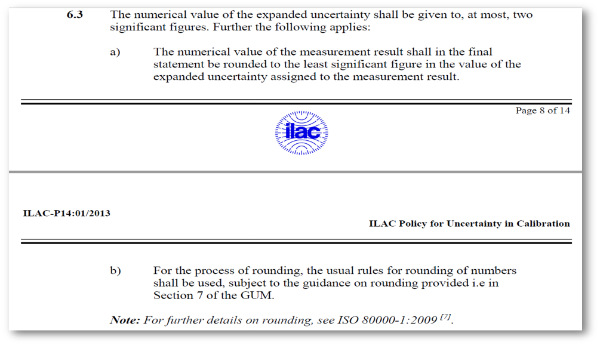
In section 6.3, the policy states that you should round measurement uncertainty to two significant figures and use the rounding method provided in section 7 of the GUM.
4. Uncertainty Components for Calibration Uncertainty
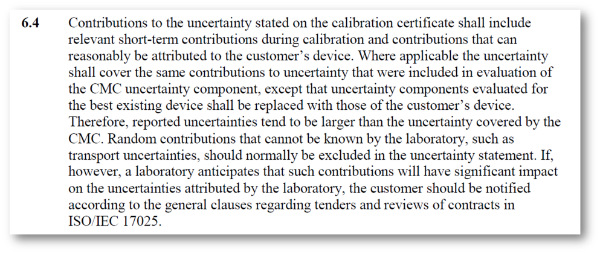
In section 6.4, the policy states that you include the following sources of uncertainty when estimating measurement uncertainty for your calibration reports;
- CMC Uncertainty,
- UUT Resolution, and
- UUT Repeatability.
5. Do Not Report Uncertainty Smaller Than Your CMC Uncertainty

In section 6.5, the policy states that you should not report measurement uncertainty values that are smaller or less than the CMC Uncertainty listed in your scope of accreditation.
ISO/IEC 17025:2017
Overall, the requirements in the ISO/IEC 17025 standard for reporting uncertainty in measurement are very straightforward.
1. Reporting Measurement Uncertainty in Test Reports
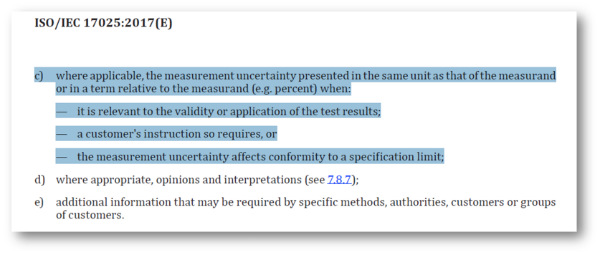
In section 7.8.3.1c, the ISO/IEC 17025:2017 states that you should report uncertainty in your test reports when;
- It is relevant to the validity of the test results,
- A customer requests it, or
- It affects conformity to a specification limit.
Additionally, when you report uncertainty, it should be reported in the same unit of measurement as the result or in a unit relative (e.g percent) to the result.
2. Reporting Measurement Uncertainty in Calibration Reports
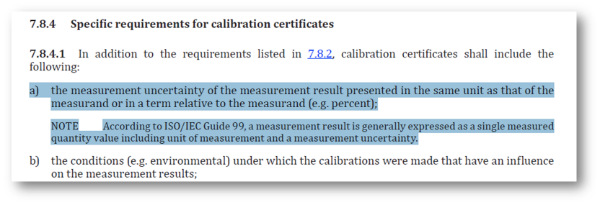
In section 7.8.4.1a, the ISO/IEC 17025:2017 states that you should report uncertainty in your calibration reports;
- In the same unit as the measurement result, or
- In a term relative to the measurement result (e.g. percent).
Unlike test reports, the standard does not give you the option to omit reporting uncertainty. Therefore, you should always report uncertainty in calibration reports.
3. Reporting Measurement Uncertainty When Reporting Sampling

In section 7.8.5f, the ISO/IEC 17025:2017 states that you should include information needed to evaluate measurement uncertainty in subsequent tests or calibrations.
How to Report Measurement Uncertainty
When reporting uncertainty in measurement, follow this five-step process;
- Record the measurement result
- Estimate the uncertainty in measurement
- Round uncertainty to two significant figures
- Round the measurement result to match the uncertainty
- Report the results
- Include an uncertainty statement
1. Record the measurement result
The first step to reporting uncertainty is to know the value of the measurement result. Therefore, you must start the process by performing a measurement and recording the result.
Using the example in the GUM, imagine that measure the resistance of a resistor and find it’s value to be 10.05762 Ohms.
Record the resistance value as the measurement result.

2. Estimate uncertainty in measurement
After recording your measurement result, you can estimate the uncertainty in measurement.
Following the recommendations of the ILAC P14, estimate your uncertainty in measurement including these three factors;
- CMC Uncertainty
- UUT Resolution
- UUT Repeatability
After combining these three factors and calculating the expanded uncertainty to 95% where k=2, you should have a value for calibration uncertainty.

3. Round uncertainty to two significant figures
Now that uncertainty has been estimated for the measurement result, it is time to round uncertainty to two significant figures.
To do this, find your first two significant figures. Then, use conventional rounding to round up or down to the nearest number.

4. Round the result to match the uncertainty
Next, round the measurement result to be consistent with the measurement uncertainty.
Since the estimated uncertainty does not give you enough accuracy to justify the value of the measurement result, round the measurement result to match the accuracy of the uncertainty.

There is no point in reporting a measurement result beyond the number of digits given in the estimated uncertainty. So, just round your measurement result to match the number of digits given in your estimated uncertainty.
5. Report the results
Report the results in your test or calibration certificate.
There several ways that you can report uncertainty in your test or calibration reports. You can report the results;
- Alongside your test or measurement results,
- In a sentence or statement, or
- In a table or uncertainty budget.
Choose the method that works best for you.
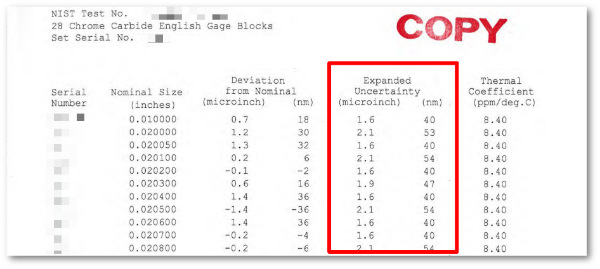
6. Include an uncertainty statement
Finally, provide a statement that explains how your customers should interpret the reported measurement uncertainty.
Your certificate must include a statement that gives;
- Information about uncertainty statements,
- The coverage factor, and
- The coverage probability.
To give you an idea, here is a general statement that you could use in your certificates.
“Reported uncertainties were estimated in accordance with the [insert method here] expressed to a 95% confidence interval where k=2.”
Significant Figures
Significant figures is an important concept that confuses many people. Therefore, I am going to try to simplify it for you.
Significant Figures Definition
According to the Oxford Advanced Learner’s Dictionary, significant figures are each of the digits of a number that are used to express it to the required degree of accuracy, starting from the first nonzero digit.
Now, the definition may not make sense to you at first. However, it will become much clearer after you review the rules for determining significant figures.
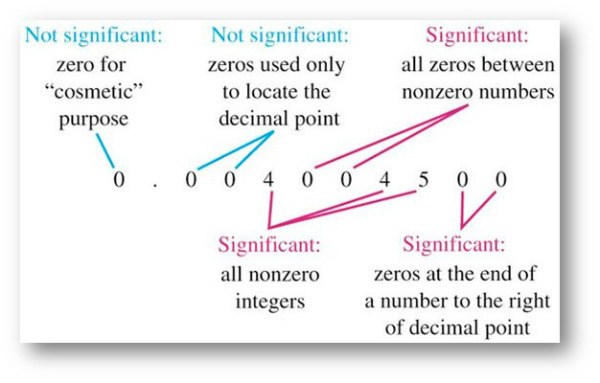
Rules for Determining Significant Figures
To determine which figures are significant, follow the rules listed below.
- Any digit that is not zero is significant;
- Zeros between nonzero digits are significant;
- Zeros to the left of the first nonzero digit are not significant;
- Numbers that contain a decimal point; all trailing zeros count as significant figures;
- Numbers that do not contain a decimal point; all trailing zeros may or may not be significant.
In the image below, you will see examples of these rules in use so you can learn how to determine the number of significant figures.
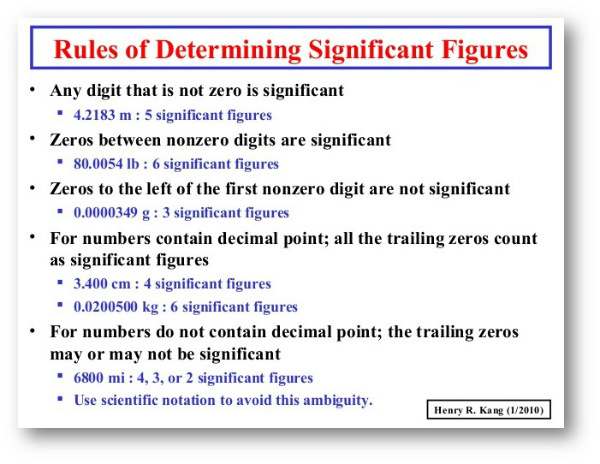
Easy Solution For Significant Figures
Are you still confused by significant figures?
Try using scientific notation. It will make it easier for you report uncertainty to two significant figures.
Significant figures are much easier and less confusing when you use scientific notation and it will help you avoid making mistakes.
Take a look at the example below. Fluke Calibration uses scientific notation in many of their calibration reports.
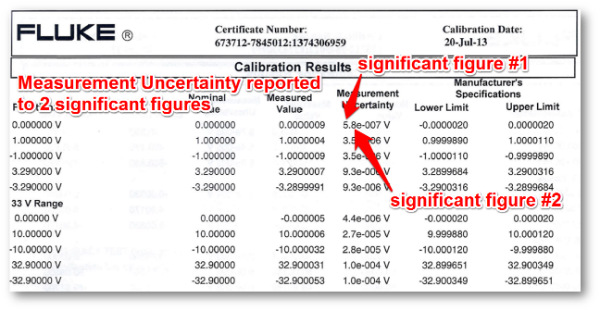
As you can see, they report only two significant figures using scientific notation.
It is not the easiest way to provide information to your customers, but it is the easiest way for your laboratory to comply with ISO/IEC 17025 requirements.
Rounding Uncertainty
When you need to round uncertainty, keep it simple and use conventional rounding.
Despite other recommendations to round up or to even numbers, I recommend that you simply use conventional rounding. This will help you reduce confusion in the laboratory and ensure that everyone provides consistent results.
In fact, conventional rounding is the method recommended by the GUM (JCGM 100:2008). According to section 7.2.6, the GUM states;
“In reporting final results, it may sometimes be appropriate to round uncertainties up rather than to the nearest digit… However, common sense should prevail…”
To do this, just follow the rules for conventional rounding;
- Round up if a number is greater than or equal to 5,
- Round down if a number is less than 5.
For example, if you follow the rules above, you will round 10.5mV up to 11mV and round 10.4mV down to 10mV.
- Round 10.5mV up to 11mV
- Round 10.4mV down to 10mV
PRO TIP: To make rounding and reporting uncertainty easy, use scientific notation.
Using scientific notation makes it easy for laboratories to meet requirements and minimize mistakes. However, reporting results in scientific notation it makes it more difficult for your customers to read and understand the results.
From my own experience, it takes me longer to evaluate reports that use scientific notation. Typically, I have to convert the result back to a number and convert it again to match the magnitude of the measurement result.
These are extra steps that I do not like to take to evaluate results. It wastes time and hurts user experience. Therefore, I do not use scientific notation.
Reporting Uncertainty Examples
If you are looking for ideas to report uncertainty in your test or calibration certificates, get inspiration from looking at other laboratories reports.
It’s a fast and efficient way to find a solution that meets requirements. Just follow this simple three step process;
- look at test and calibration certificates from accredited laboratories,
- choose the format that you like best, and
- implement it in your own certificates.
It’s that easy!
As a result, you will know that you are issuing certificates that meet requirements without having to spend a lot of time on research and design.
To give you inspiration, I have a few examples to share with you from some of the biggest brand laboratories in the US.
Fluke Report Example
Below is an exert of a calibration report issued by Fluke. Notice that they report an uncertainty next to every measurement result.
Additionally, Fluke typically reports measurement uncertainty in scientific notation.
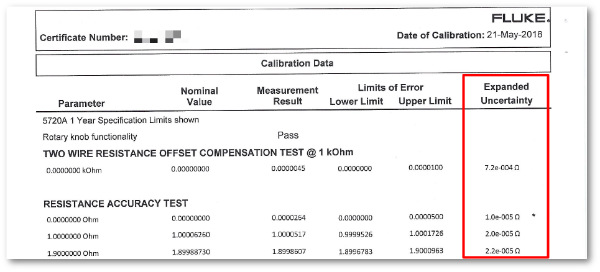
In the image below, take a look at the statement Fluke uses to explain how you should interpret their reported estimates of uncertainty in measurement.
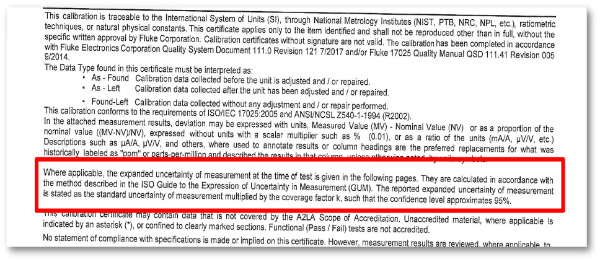
NIST Report Example
Below is an exert of a calibration report issued by NIST. Notice that they report an uncertainty next to every measurement result.
Additionally, NIST typically reports measurement uncertainty in the same units of measure as the measurement results.

In the image below, take a look at the statement NIST uses to explain how you should interpret their reported estimates of uncertainty in measurement.

Tektronix Report Example
Below is an exert of a calibration report issued by Tektronix. Notice that they report an uncertainty next to every measurement result.
Additionally, Tektronix typically reports measurement uncertainty in the same units of measure as the measurement results.
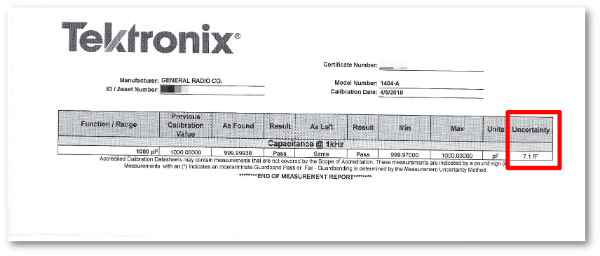
In the image below, take a look at the statement Tektronix uses to explain how you should interpret their reported estimates of uncertainty in measurement.

Keysight Report Example
Below is an exert of a calibration report issued by Keysight. Notice that they report an uncertainty next to every measurement result.
Additionally, Keysight typically reports measurement uncertainty in the same units of measure as the measurement results.
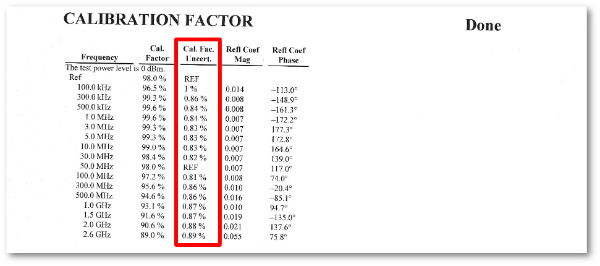
In the image below, take a look at the statement Keysight uses to explain how you should interpret their reported estimates of uncertainty in measurement.
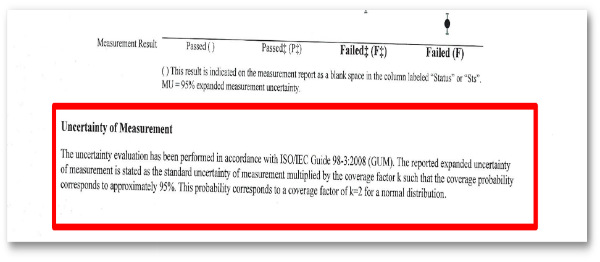
Mitutoyo Report Example
Below is an exert of a calibration report issued by Mitutoyo. Notice that they do not report an uncertainty next to every measurement result. They list it separately.
Additionally, Mitutoyo typically reports measurement uncertainty in the same units of measure as the measurement results.
Finally, take a look at the statement Mitutoyo uses to explain how you should interpret their reported estimates of uncertainty in measurement.
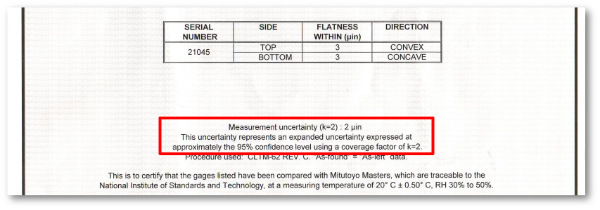
Conclusion
Reporting measurement uncertainty in your test or calibration certificates can be a challenge. There are a lot of rules to follow for ISO/IEC 17025 accreditation.
In this guide, you should have learned;
- The requirements for reporting uncertainty,
- The 6 step process to reporting uncertainty,
- What are significant figures,
- How to round uncertainty, and
- How to present uncertainty in your certificates.
Overall, we have covered a lot of information that should help you easily report measurement uncertainty and meet ISO/IEC 17025 requirements.
If your certificates are not currently meeting these requirements, then give this process a try and let me know if you have any questions.
Also, feel free to leave a comment below telling us how you report uncertainty.




One Comment